By: mikeykremer , Messari Researcher
Compiled by: ChatGPT
Take a peek:
- Globalization is over and your financial assets have been liquidated.
- Non-traditional assets are your salvation.
- Bitcoin could reach a million dollars.
From the outbreak of World War II (1939) to Trump's second election victory (2024), we have experienced an unprecedented super bull market. This continuous rise has shaped generations of passive investors who are accustomed to believing that "the market will never go wrong" and "the market will only go up." However, I think the party is over and many people are about to face a reckoning.
How did we get here?
The super bull market from 1939 to 2024 was not accidental, but was the result of a series of structural changes that completely reshaped the global economy, with the United States always at the center.
Rise to global superpower after World War II
World War II propelled the United States from a middle power to the undisputed leader of the “free world.” By 1945, the United States produced more than half of the world’s industrial output, controlled a third of global exports, and held about two-thirds of the world’s gold reserves. This economic hegemony laid the foundation for decades of growth that followed.
Unlike the isolationism of the United States after World War I, the United States actively embraced the role of global leadership after World War II, promoted the establishment of the United Nations, and implemented the "Marshall Plan", injecting more than $13 billion into Western Europe. This was more than just aid - by investing in the reconstruction of post-war countries, the United States created new markets for its products and established its cultural and economic dominance.
Labor Force Expansion: Women and Minorities
During World War II, approximately 6.7 million women entered the labor force, increasing the female labor force participation rate by nearly 50% in just a few years. Although many women left the workforce after the war, this mass mobilization permanently changed society’s view of women’s employment.
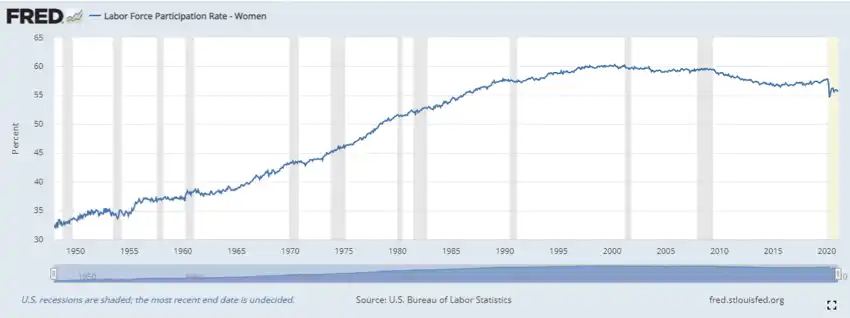
By 1950, the trend of large-scale employment of married women was becoming more and more obvious, and the female labor force participation rate for most age groups increased by an unprecedented 10 percentage points. This was not just a wartime exception, but the starting point of a fundamental change in the American economic model. The repeal of the "marriage ban" (the policy that prohibited married women from working), the increase of part-time work, the innovation of housework technology, and higher education levels all prompted women to transform from temporary workers to permanent participants in the economic system.
Similar trends occurred among minority groups, who gradually gained more economic opportunities. These labor force expansions effectively increased America’s production capacity and supported decades of economic growth.
Victory in the Cold War and the Wave of Globalization
The Cold War shaped the political and economic role of the United States after World War II. By 1989, the United States had formed military alliances with 50 countries and stationed 1.5 million troops in 117 countries around the world. This was not only for military security, but also to establish the United States' economic influence around the world.
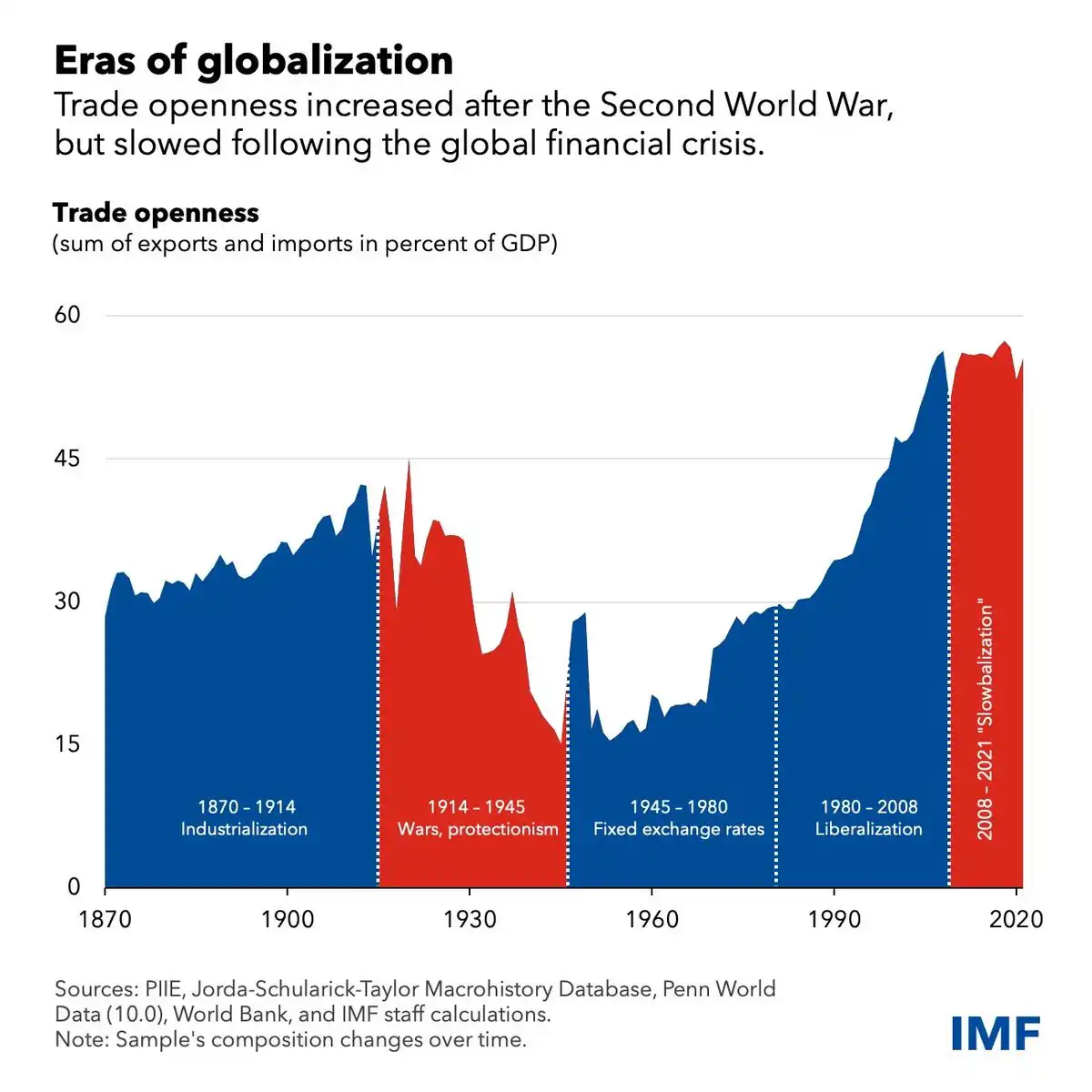
After the collapse of the Soviet Union in 1991, the United States became the world's only superpower and entered an era that many people consider to be a unipolar world. This was not only an ideological victory, but also the opening of global markets, allowing the United States to dominate the global trade pattern.
In the 1990s and early 2000s, American companies expanded aggressively into emerging markets. This was not a natural evolution, but the result of long-term policy choices. For example, in countries where the CIA intervened during the Cold War, U.S. imports increased significantly, especially in industries where the U.S. did not have a clear competitive advantage.
Western capitalism’s victory over Eastern communism was not based solely on military or ideological superiority. Western liberal democracy was more adaptable and was able to effectively adjust its economic structure after the 1973 oil crisis. The 1979 “Volcker Shock” reshaped the United States’ global financial hegemony and made the global capital market a new engine of growth for the United States in the post-industrial era.
These structural shifts—the rise to superpower status after World War II, the entry of women and minorities into the labor force, and victory in the Cold War—have together fueled an unprecedented super bull run in financial assets. Yet here’s the core problem: These shifts were one-off events and cannot be repeated. You can’t get women into the labor force again, and you can’t beat the Soviet Union again. And now, with a bipartisan push for deglobalization, we are seeing the last legs of this super-long cycle of growth being pulled away.
What happens next?
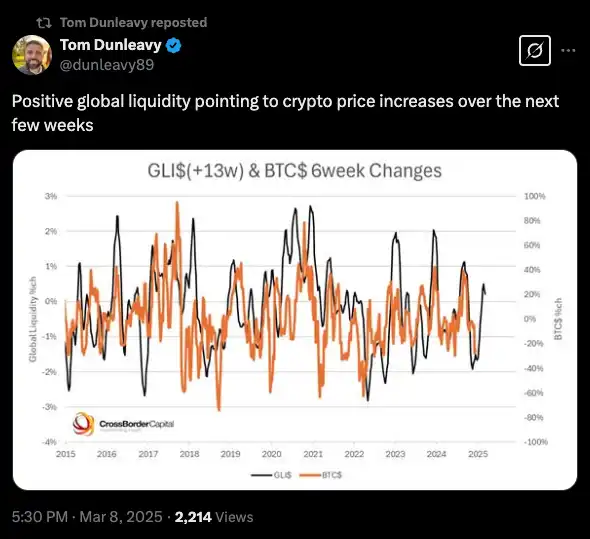
I like Tom, he is my TradFi sentiment indicator in the Crypto circle
Unfortunately, everyone is praying that the market will return to historical normalcy. The market consensus is: things will get worse, then the central bank will start flooding the market with money, and we can continue to make money...but the reality is: this group of people are heading to the slaughterhouse.
The nearly century-long bull market was built on a series of events that cannot be repeated (cannot continue the bull market), and some of these factors are even reversing.
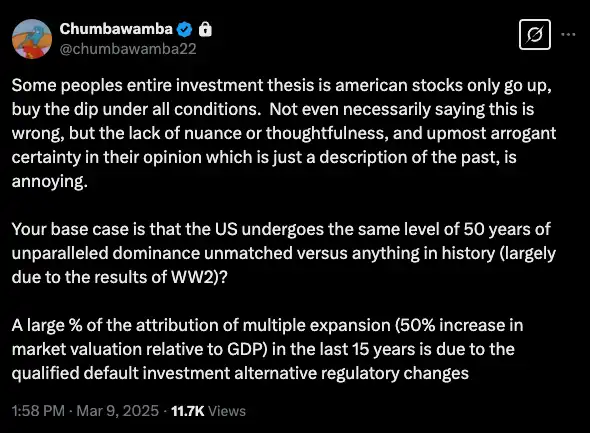
Chumba is right about this .
- Women won’t reenter the workforce in large numbers: In fact, as Musk and pro-birth elites push for higher fertility rates, female labor force participation rates may fall back.
- Minorities will not be absorbed into the labor market in large numbers again: In fact, it has become a bipartisan consensus that the Democrats' stance on immigration policy is almost as tough as that of the Republicans.
- Interest rates won’t fall again: Virtually every elected leader knows that inflation is the biggest threat to their reelection. So governments will do everything they can to avoid cutting rates and reigniting inflation.
- We will not have further globalization: in fact, Trump is moving in the exact opposite direction, and I expect the Democrats will replicate this policy in the next election (remember, most of Biden’s policies are directly copied from Trump’s first term).
- We are not going to win another world war: in fact, it looks like we might even lose the next one. Anyway, I don’t want to test this conjecture.
My point is simple: All the global macro trends that have driven stock markets higher over the past century are now reversing. Where do you think the market is headed?
Goblin Town
When an empire goes into decline, times are really hard - just ask Japan. If you bought the Nikkei 225 at its all-time high in 1989 and held on to it today, 36 years later, your return would be about -5%. That's classic "buy and hold, and be miserable". I think we are on the same path.
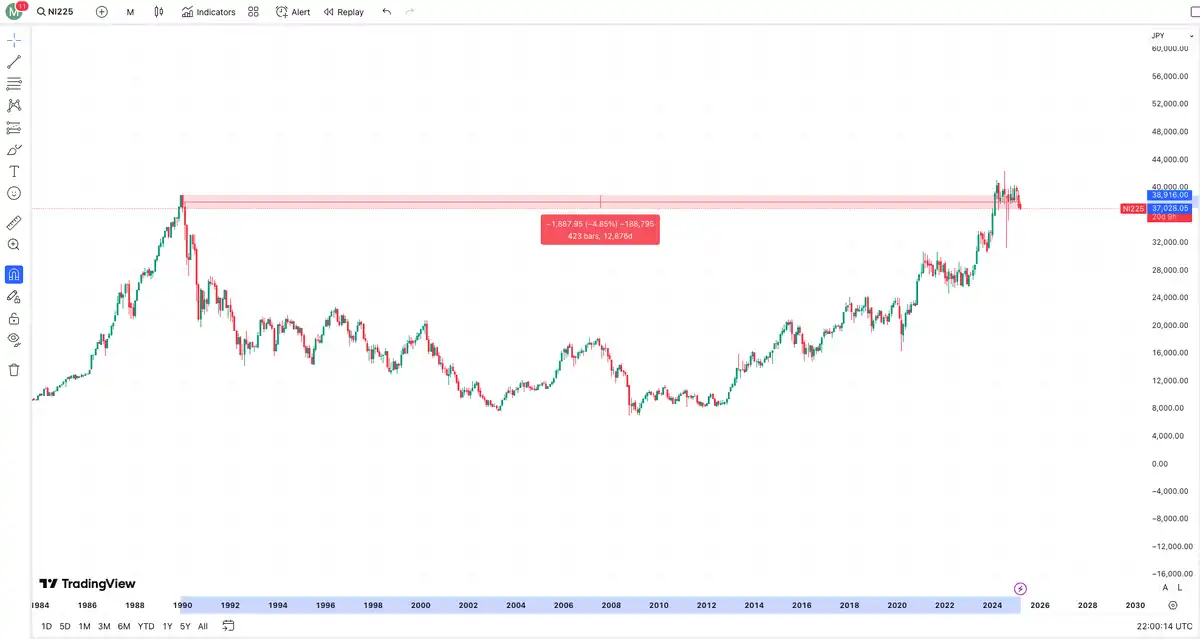
Worse still, you should be prepared for capital controls and fiscal repression. Just because the market won’t rise doesn’t mean the government will accept reality. When traditional monetary policy fails, the government will turn to more direct financial control measures.
Capital controls coming
Financial repression refers to giving savers returns below the level of inflation so that banks can provide cheap loans to companies and governments and reduce the pressure to repay debts. This strategy is particularly effective when governments liquidate their own currency debts. The term was first used by Stanford University economists in 1973 to criticize policies that stifle economic growth in emerging market countries, but today these strategies are increasingly seen in developed economies such as the United States.
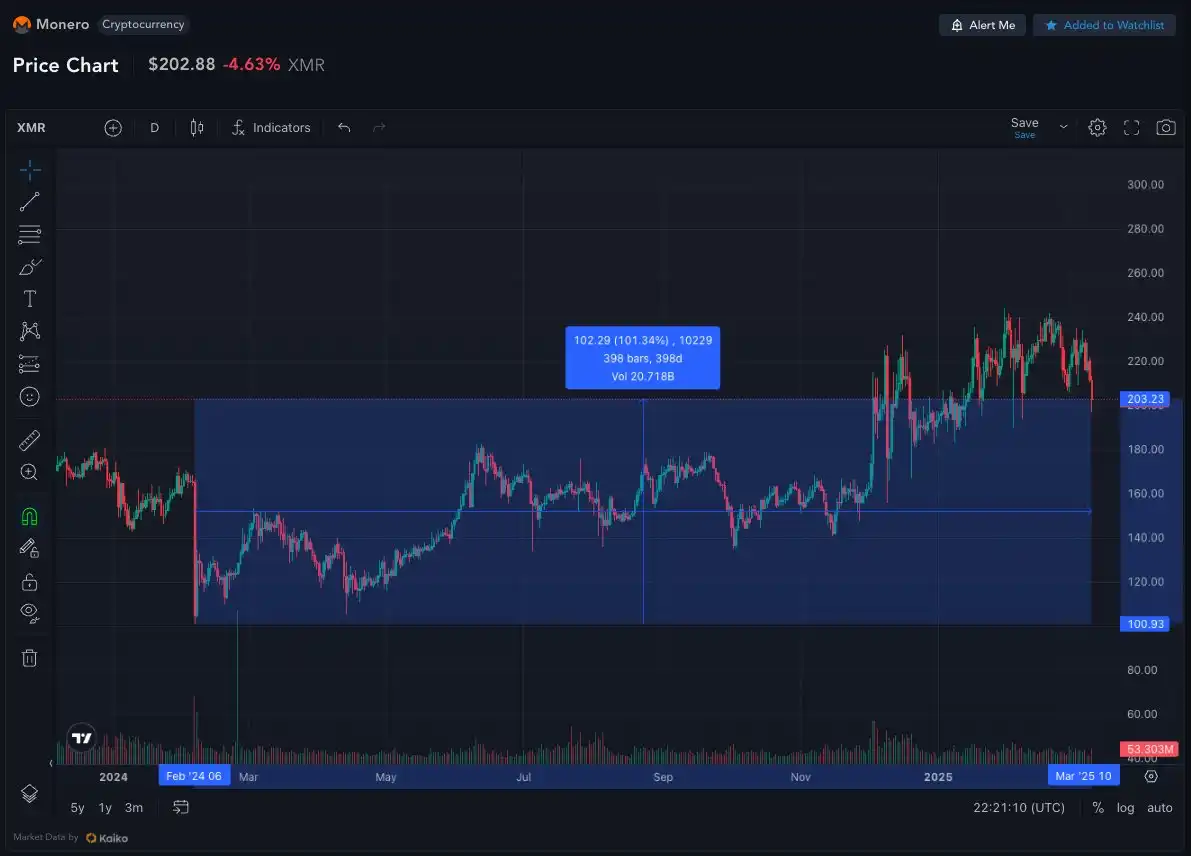
This may sound like a joke, but you should seriously think about why the Monero candlestick chart looks so perfect right now.
As the US debt burden exceeds 120% of GDP, the possibility of repaying the debt through traditional means is becoming increasingly dwindling. The “playbook” of financial repression has begun to be implemented or tested, including:
- Directly or indirectly limit government debt and deposit rates
- Governments control financial institutions and create barriers to competition
- High reserve requirements
- Creating a closed domestic debt market, forcing institutions to buy government bonds
- Capital controls restrict cross-border flows of assets
This is not a theoretical hypothesis, but a real-life example. Since 2010, the U.S. federal funds rate has been below the inflation rate for more than 80% of the time, effectively forcibly transferring wealth from savers to borrowers (including the government).
Your retirement accounts: The government's next target
If the government can't print money to buy bonds and keep interest rates down to avoid a debt crisis, they'll go after your retirement accounts. I can imagine a future where tax-advantaged accounts like 401(k)s are forced to allocate more and more of their holdings in "safe and reliable" government bonds. The government doesn't need to print money anymore, it can just use the money already in the system.
This is exactly the script we’ve seen over the past few years:
- Freezing assets: In April 2024, Biden signed a law authorizing the government to confiscate Russia's reserve assets in the United States, setting a precedent that the government can freeze foreign exchange reserves at any time. In the future, this practice may not only target geopolitical opponents.
- Canada Freedom Caravan protests: The government froze about 280 bank accounts without court approval. Finance officials admitted that this was not only to cut off the flow of funds, but also to "deter" protesters and ensure they "make the decision to leave." When asked how the freezing of accounts affects innocent families, the government's response was: "They just need to leave."
Gold expropriation and monitoring
This is not surprising; American history is filled with similar actions:
In 1933, Roosevelt issued Executive Order 6102, forcing citizens to turn in their gold or face imprisonment. Despite limited enforcement, the Supreme Court upheld the government’s right to confiscate gold. This was not a “voluntary purchase program” but a “forced wealth expropriation” packaged as a “fair market price” transaction.
The government’s surveillance capabilities have expanded rapidly since 9/11. The FISA Amendments Act gives the NSA nearly unlimited power to monitor the international communications of American citizens. The Patriot Act allows the government to collect phone records of all Americans every day. Section 215 even allows the government to collect your reading records, study materials, purchase history, medical records, and personal financial information without any reasonable suspicion.
The question is not “will financial repression come?” but “how severe will it be?” As economic pressures from deglobalization intensify, government controls on capital will only become more direct and harsher.
Gold and Bitcoin
The monthly gold chart since 1970 is currently the strongest candlestick chart in the world.
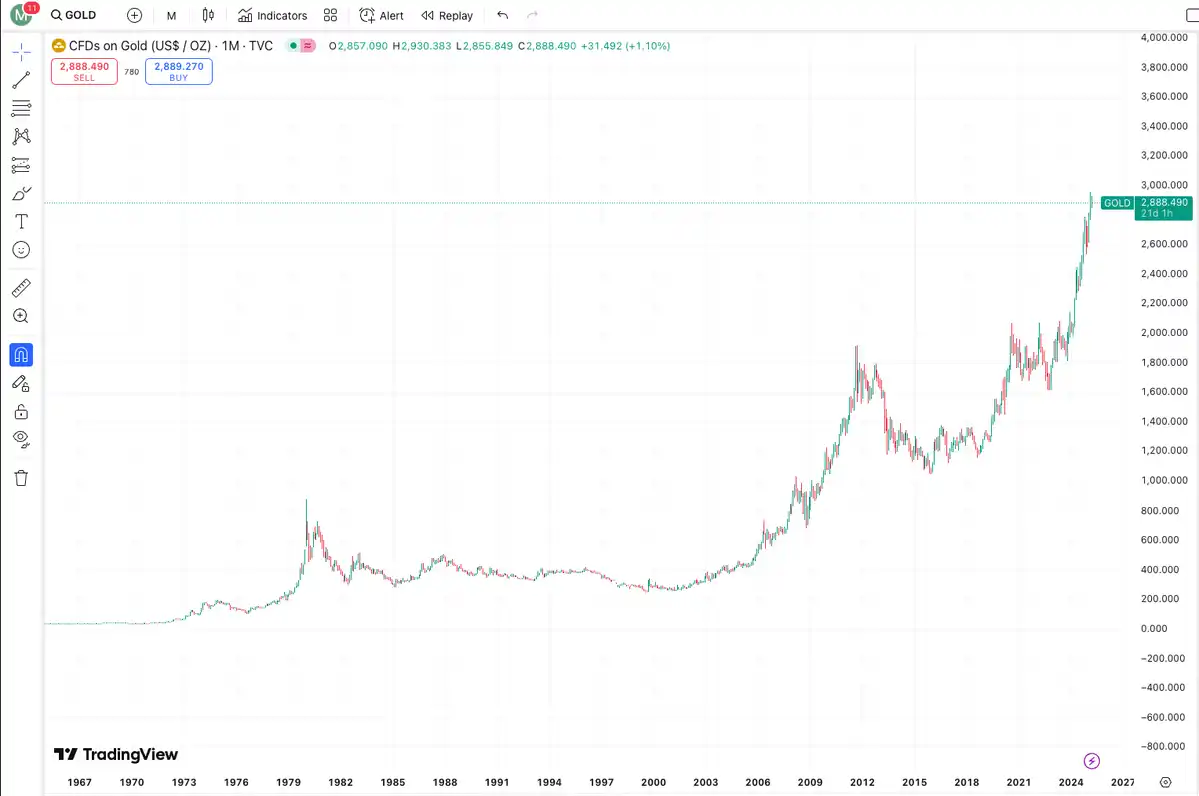
By process of elimination, the best financial asset to buy is pretty obvious - you need an asset that has no historical correlation with the market, is difficult for the government to confiscate, and is not controlled by Western governments. I can think of two, one of which has added $6 trillion in market value in the past 12 months. That's the clearest bull signal.
The global race for gold reserves
Countries such as China, Russia and India are rapidly increasing their gold reserves in response to changes in the global economic landscape:
- China: In January 2025, the country increased its gold holdings by 5 tons per month, with net purchases for three consecutive months, bringing its total holdings to 2,285 tons.
- Russia: Controls 2,335.85 tons of gold, becoming the world's fifth largest gold reserve country.
- India: Ranked eighth in the world, holding 853.63 tons, and continues to increase its holdings.
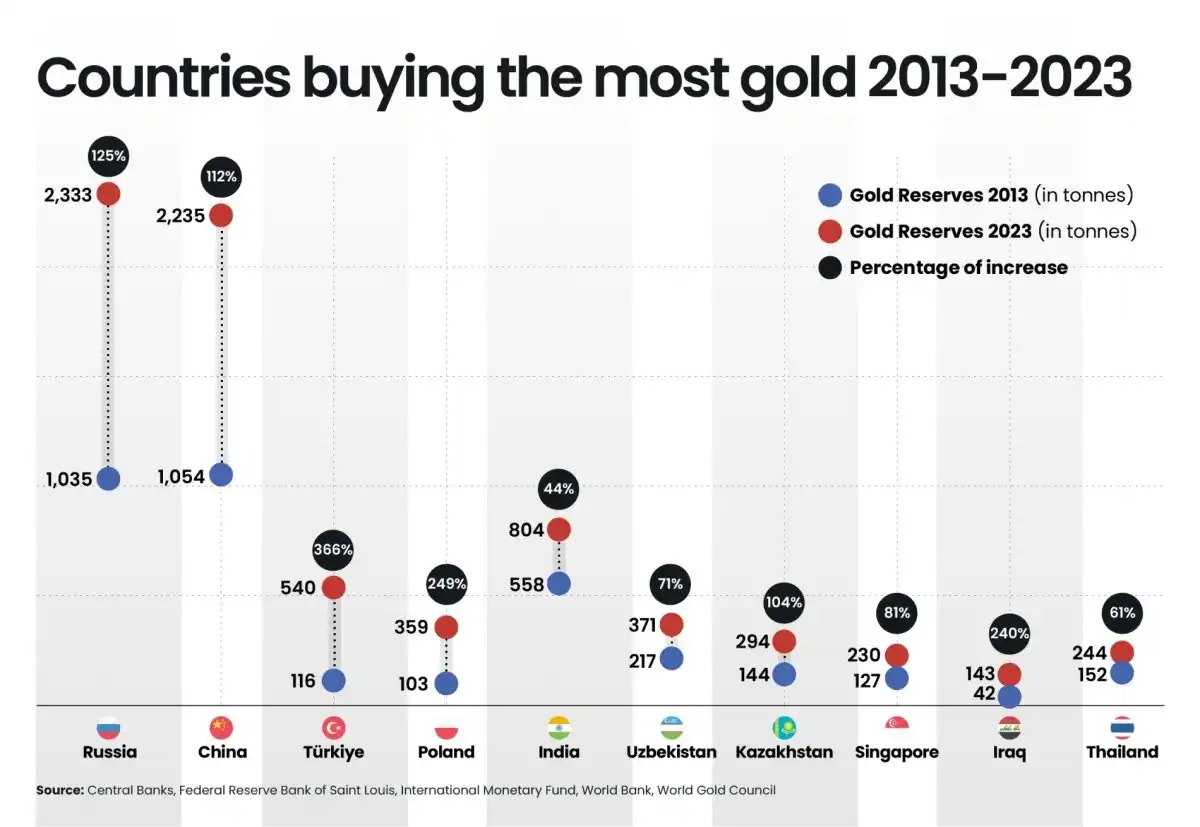
This is not a random act, but a strategic one. After the G7 froze Russia’s foreign exchange reserves, central banks around the world took notice. A survey of 57 central banks showed that 96% of respondents cited gold’s credibility as a safe-haven asset as a motivation to continue investing. When dollar-denominated assets can be frozen in one fell swoop, physical gold stored in one’s own country becomes extremely attractive.
In 2024 alone, Turkey added 74.79 tons of gold to its reserves, a 13.85% increase. Poland added 89.54 tons, a nearly 25% increase. Even a small country like Uzbekistan added 8 tons of gold in January 2025, bringing its gold holdings to 391 tons, or 82% of its reserves. This is no coincidence, but a coordinated move to rid the financial system of a potential weaponization.
Governments are most comfortable with gold because they have established systems to use it for reserves and trade settlement. The combined gold holdings of BRICS central banks account for more than 20% of global central bank gold holdings. As the governor of the Central Bank of Kazakhstan said in January 2025, they are transitioning to "currency neutrality of gold reserves" with the goal of increasing international reserves and "protecting the economy from external shocks."
Bitcoin
This era of gold dominance may last for months or even years, but eventually, its limitations will become apparent. Many small and medium-sized countries do not have adequate banking systems and navies to manage the global logistics of gold, and these countries may be the first to adopt Bitcoin as an alternative to gold.
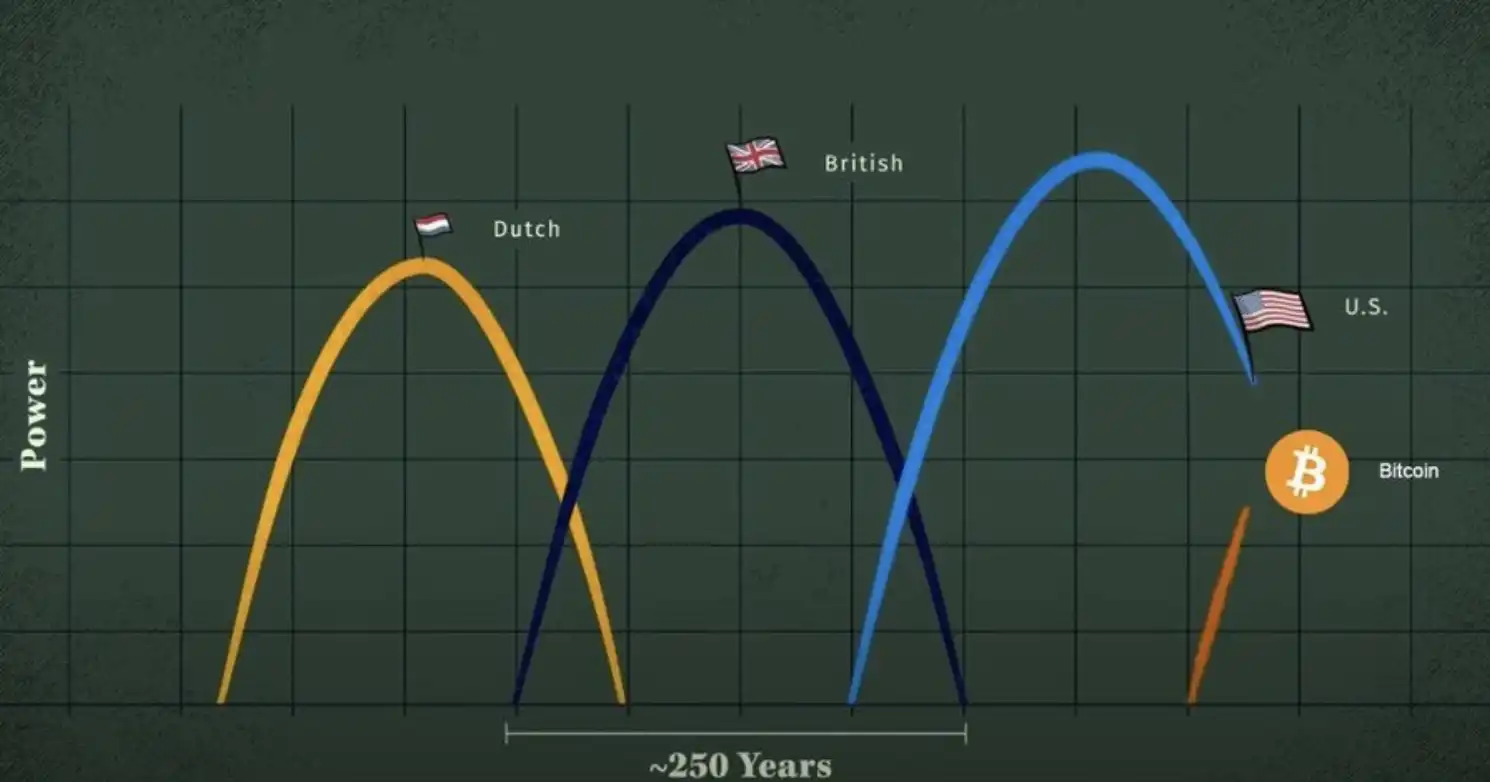
- El Salvador: In 2021, it became the first country to use Bitcoin as legal tender (later announced its cancellation). By 2025, its Bitcoin reserves had grown to more than US$550 million.
- Bhutan: Using hydroelectric power for mining, Bitcoin reserves have exceeded $1 billion, accounting for one-third of the country's GDP.
As the world becomes more chaotic, nations are less likely to hold their gold in trust with their allies. The risk of confiscation is too great, as evidenced by Venezuela’s failed attempt to reclaim its gold from the Bank of England. For smaller nations, Bitcoin offers a compelling alternative — it requires no physical vaults to store, no ships to transfer, and no military to protect.
This transition period will propel us into the next phase of Bitcoin adoption, but you have to be patient. The world doesn’t change overnight, and neither does the monetary system. As of 2025, we’re already seeing the beginnings of this shift, with Bitcoin adoption growing in countries like Argentina, Nigeria, and Vietnam as citizens seek protection against inflation and financial instability.
The path forward is clear: first gold, then bitcoin. As more countries realize the limitations of physical gold in an increasingly digital and fragmented world, the proposition of bitcoin as digital gold becomes more compelling. The question is not if this transition will happen, but when — and which countries will lead the way.
$1 million Bitcoin is coming, but you have to be patient. Be prepared for a serious bear market first.













